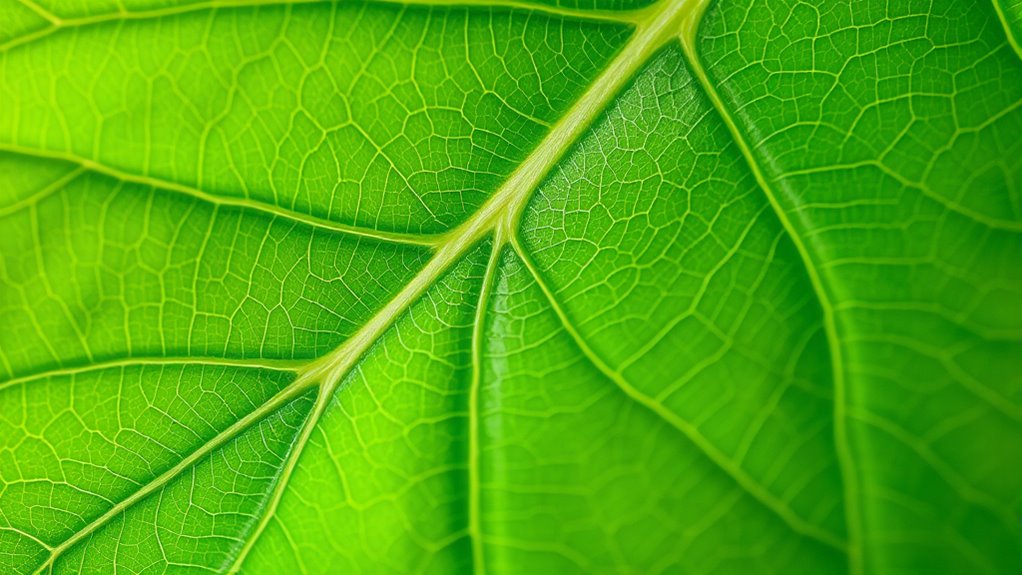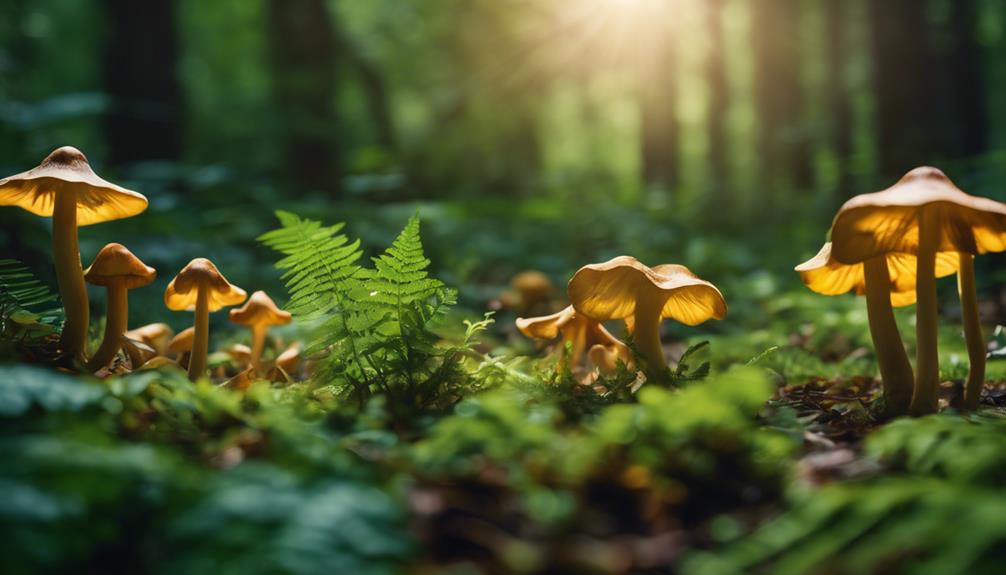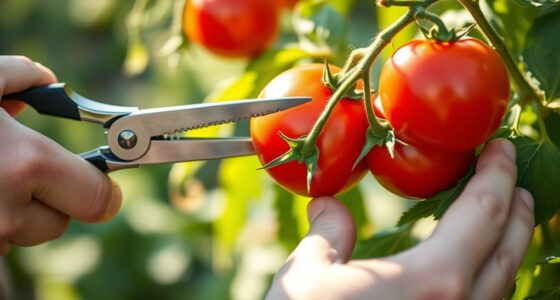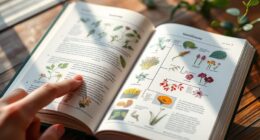By studying leaf venation patterns, you can identify plant species more quickly and accurately, as these patterns act like nature’s barcodes. You’ll notice styles like parallel, pinnate, or palmate veins, each revealing clues about the plant’s classification, environment, and health. Understanding these intricate vein designs helps you see how plants adapt and evolve. Keep exploring further, and you’ll uncover even more secrets hidden within every leaf.
Key Takeaways
- Leaf venation patterns serve as unique identifiers, similar to barcodes, aiding in accurate plant species recognition.
- Recognizing venation types (parallel, pinnate, palmate) helps distinguish plant families and ecological adaptations.
- Studying vein arrangements provides insights into a plant’s evolutionary stage and environmental niche.
- Comparing venation styles enhances plant identification skills through visual observation and pattern analysis.
- Decoding leaf venation supports ecological research, conservation efforts, and understanding plant diversity.

Have you ever wondered how the intricate patterns of leaf veins reveal a plant’s hidden secrets? When you examine a leaf closely, you’ll notice a network of lines spreading across its surface, but these aren’t just random markings—they’re a key to understanding the plant’s identity. Leaf vein types and venation patterns are like nature’s barcodes, unique to each species and essential for identifying plants accurately. By paying attention to these details, you can unlock valuable information about a plant’s classification, health, and adaptation strategies. Recognizing venation patterns also helps in understanding plant evolution, providing insights into how different species have adapted over time to their environments.
Leaf vein patterns are nature’s barcodes, revealing a plant’s identity, health, and adaptation secrets.
There are primarily three leaf vein types that you’ll encounter: parallel, pinnate, and palmate. Parallel venation is common in monocots like grasses and lilies, where veins run side by side from the leaf base to the tip. This pattern tends to be straightforward, making it easy to distinguish and recognize. Pinnate venation, found in many dicots such as roses and oaks, features a central main vein—the midrib—from which smaller secondary veins branch out on either side. Palmate venation is characterized by several main veins radiating from a single point near the leaf’s base, similar to the fingers spreading from the palm of a hand, seen in plants like maples and buttercups. Each of these leaf vein types serves different functions, influencing how the plant transports nutrients, supports leaf structure, and adapts to its environment.
Understanding venation patterns’ significance goes beyond mere identification. These patterns reveal evolutionary relationships, helping botanists classify plants more precisely. For example, the complexity of venation can indicate a plant’s evolutionary stage or ecological niche. The arrangement and density of veins affect how efficiently a leaf can conduct water and nutrients, which directly impacts its resilience and growth. A dense, reticulate (net-like) venation pattern often signifies a plant that needs robust support and efficient transport, which can be essential in dry or nutrient-poor environments. Conversely, simpler venation might be typical of plants in shaded or moist habitats, where less structural support is necessary.
In practical terms, recognizing venation patterns can assist you in identifying a plant in the wild or in your garden. It’s a process of observation and comparison—notice the style and arrangement of veins and relate them to known patterns. Over time, you’ll develop an intuitive feel for how different venation types and patterns relate to specific plant families or ecological strategies. Decoding leaf venation isn’t just an academic exercise; it’s a way to connect more deeply with nature, revealing the hidden language written in every leaf. When you understand these patterns, you gain a powerful tool for exploring the plant kingdom’s diversity and complexity, making every walk through nature a journey of discovery.
Frequently Asked Questions
How Does Leaf Venation Vary Across Different Plant Families?
You’ll notice that leaf venation varies greatly across plant families, showcasing venation diversity that helps distinguish them. Some have parallel veins, typical in monocots, while others display reticulate patterns, common in dicots. This variation has evolutionary significance, reflecting adaptations to different environments and functions. By understanding these differences, you can better identify plant families and appreciate how venation patterns evolve to meet specific ecological needs.
Can Leaf Venation Patterns Change Over a Plant’s Lifespan?
They say, “The more things change, the more they stay the same.” Leaf venation patterns can indeed change over a plant’s lifespan due to leaf aging and environmental adaptation. As leaves mature, their venation may become more prominent or slightly altered, helping the plant adapt to varying conditions. These changes reflect a plant’s ability to respond and survive, showing that venation patterns are dynamic rather than fixed.
Are Some Venation Types More Resistant to Environmental Stress?
Some venation types offer better venation resilience, making them more resistant to environmental stress. You’ll find that reticulate venation often demonstrates higher stress tolerance, thanks to its complex network that distributes resources efficiently. In contrast, parallel venation may be less adaptable under stress. By understanding these differences, you can predict how plants respond to changing conditions, enhancing your ability to select resilient species for diverse environments.
How Do Leaf Venation Patterns Influence a Plant’s Water Transportation?
You might think leaf veins are just pretty patterns, but they’re actually vital for water transport. Their venation patterns influence xylem efficiency, ensuring water reaches every leaf corner. They also help regulate transpiration, preventing water loss during dry spells. So, these intricate designs act like nature’s plumbing system, balancing water flow and conserving moisture. Ironically, the complexity keeps plants alive, even in the harshest conditions.
Can Leaf Venation Be Used to Identify Fossilized Plants?
You can use leaf venation to identify fossilized plants because venation patterns are unique and preserved in fossils. By analyzing these patterns, you aid in fossil identification and ancient plant analysis. Recognizing venation types helps differentiate species and understand plant evolution. Your work with fossilized leaves provides valuable insights into past ecosystems and biodiversity, making leaf venation a vital tool in paleobotany and fossil studies.
Conclusion
Just like a barcode reveals a product’s identity, leaf venation holds the secret to plant recognition. By decoding these intricate patterns, you unearth nature’s hidden signatures, each one a symbol of life’s complexity. As you learn to read these delicate lines, you become a detective of the natural world, uncovering stories woven into every leaf. Embrace this knowledge, and you’ll see plants not just as scenery, but as silent storytellers whispering their unique identity.










